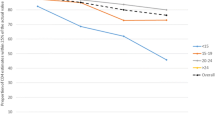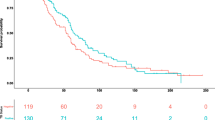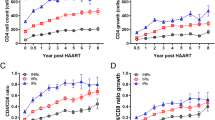Summary
CD4 count is the standard method for determining eligibility for highly active antiretroviral therapy (HAART) and monitoring HIV/AIDS disease progression, but it is not widely available in resource-limited settings. This study examined the correlation between total lymphocyte count (TLC) and CD4 count of HIV-infected patients before and after HAART, and assessed the thresholds of TLC for making decisions about the initiation and for monitoring HAART. A retrospective study was performed, and 665 HIV-infected patients with TLC and CD4 count from four counties (Shangcai, Queshan, Shenqiu and Weishi) were included in the study. Pearson correlation and receiver operating characteristic (ROC) were used. TLC and CD4 count after HAART was significantly increased as compared with pre-HAART (P<0.01). An overall positive correlation was noted between TLC and CD4 count (pre-HAART, r=0.73, P=0.0001; follow-up HAART, r=0.56, P=0.0001). The ROC curve between TLC and CD4 count showed that TLC ≤ 1200 cells/mm3 could predict CD4 < 200 cells/mm3 with a sensitivity of 71.12%, specificity of 66.35% at pre-HAART. After 12-month HAART, the optimum prediction for CD4 count < 200 cells/mm3 was a TLC ≤ 1300 cells/mm3, with a sensitivity of 63.27%, and a specificity of 74.84%. Further finding indicated that TLC change was positively correlated to CD4 change (r=0.77, P=0.0001) at the time point of 12-month treatment, and the best prediction point of TLC change for CD4 increasing was 135 cells/mm3. TLC and its change can be used as a surrogate marker for CD4 count and its change of HIV-infected individuals for making decisions about the initiation and for monitoring HAART in resource-limited settings.
Similar content being viewed by others
References
Gautam H, Saini S, Bhalla P, et al. Use of total lymphocyte count to predict absolute CD4 count in HIV-seropositive cases. J Int Assoc Physicians AIDS Care (Chic Ill), 2010,9(5):292–295
Aragonès G, Beltrán-Debón R, Rull A, et al. Human immunodeficiency virus-infection induces major changes in high-density lipoprotein particle size distribution and composition: the effect of antiretroviral treatment and disease severity. Clin Chem Lab Med, 2010,48(8): 1147–1152
Chaudhary M, Kashyap B, Gautam H, et al. Use of surrogate markers to predict the HIV disease stage and time to initiate antiretroviral therapy in developing countries. J Int Assoc Physicians AIDS Care (Chic Ill), 2008,7(5): 259–264
Mahajan AP, Hogan JW, Snyder B, et al. Changes in total lymphocyte count as a surrogate for changes in CD4 count following initiation of HAART: implications for monitoring in resource-limited settings. J Acquir Immune Defic Syndr, 2004,36(1):567–575
Srirangaraj S, Venkatesha D. Total lymphocyte count as a tool for timing opportunistic infection prophylaxis in resource-limited settings: a study from India. J Infect Dev Ctries, 2010,4(10):645–649
Kumarasamy N, Mahajan AP, Flanigan TP, et al. Total lymphocyte count (TLC) is a useful tool for the timing of opportunistic infection prophylaxis in India and other resource-constrained countries. J Acquir Immune Defic Syndr, 2002,31(4):378–383
Baker CA, Clark R, Ventura F, et al. Peripheral CD4 loss of regulatory T cells is associated with persistent viraemia in chronic HIV infection. Clin Exp Immunol, 2007, 147(3):533–539
Florence E, Dreezen C, Schrooten W, et al. The role of non-viral load surrogate markers in HIV-positive patient monitoring during antiviral treatment. Int J STD AIDS, 2004,15(8):538–542
Anastos K, Shi Q, French AL, et al. Total lymphocyte count, hemoglobin, and delayed-type hypersensitivity as predictor of death and AIDS illness in HIV-1 infected women receiving highly active antiretroviral therapy. J Acquir Immuno Defic Syndr, 2004,35(4):383–592
Lau B, Gange SJ, Phair JP, et al. Rapid declines in total lymphocyte counts and hemoglobin concentration prior to AIDS among HIV-1-infected men. AIDS, 2003,17(14): 2035–2044
Li X, Xu Y, Nie S, et al. The effect evaluation of highly active antiretroviral therapy to patients with AIDS in Hubei province of China. J Huazhong Univ Sci Technol [Med Sci], 2009,29(5):580–584
World Health Organization. Antiretroviral therapy for HIV infection in adults and adolescents: Recommendations for a public health approach. Available: www.who.int. Accessed 4 March 2010
Daka D, Loha E. Relationship between total lymphocyte count (TLC) and CD4 count among peoples living with HIV, Southern Ethiopia: a retrospective evaluation. AIDS Res Ther, 2008,5:26.
Chaisson RE, Keruly JC, Moore RD. Association of initial CD4 cell count and viral load with response to highly active antiretroviral therapy. JAMA, 2000,284(24): 3128–3129
Cheung C, Shuter J. Pneumocystis jirovecii prophylaxis discontinuation based upon total lymphocyte count in HIV-infected adults treated with antiretroviral therapy. Int J STD AIDS, 2010,21(6):406–409
Yeni PG, Hammer SM, Carpenter CC, et al. Antiretroviral treatment for adult HIV infection in 2002: updated recommendations of the International AIDS Society-USA Panel. JAMA, 2002,288(2):222–235
Sabin CA, Lampe FC, Chaloner C, et al. An audit of antiretroviral treatment use in HIV-infected patients in a London clinic: the limitations of observational databases when auditing antiretroviral treatment use. HIV Med, 2003,4(2): 87–93
Akinola NO, Olasode O, Adediran IA, et al. The search for a predictor of CD4 cell count continues: total lymphocyte count is not a substitute for CD4 cell count in the management of HIV-infected individuals in a resource-limited setting. Clin Infect Dis, 2004,39(4): 579–581
Gupta A, Gupte N, Bhosale R, et al. Low sensitivity of total lymphocyte count as a surrogate marker to identify antepartum and postpartum Indian women who require antiretroviral therapy. J Acquir Immune Defic Syndr, 2007, 46(3):338–342
Mwamburi DM, Ghosh M, Fauntleroy J, et al. Predicting CD4 count using total lymphocyte count: a sustainable tool for clinical decisions during HAART use. Am J Trop Med Hyg, 2005,73(1):58–62
Author information
Authors and Affiliations
Corresponding author
Additional information
The research was supported by a grant from the Key Projects in the National Science & Technology Pillar Program during the Eleventh Five-Year Plan Period of China (No. 2009ZX10001-017).
Rights and permissions
About this article
Cite this article
Wang, Y., Liang, S., Yu, E. et al. Correlation analysis on total lymphocyte count and CD4 count in HIV-infected patients: A retrospective evaluation. J. Huazhong Univ. Sci. Technol. [Med. Sci.] 31, 712–716 (2011). https://doi.org/10.1007/s11596-011-0588-8
Received:
Published:
Issue Date:
DOI: https://doi.org/10.1007/s11596-011-0588-8




